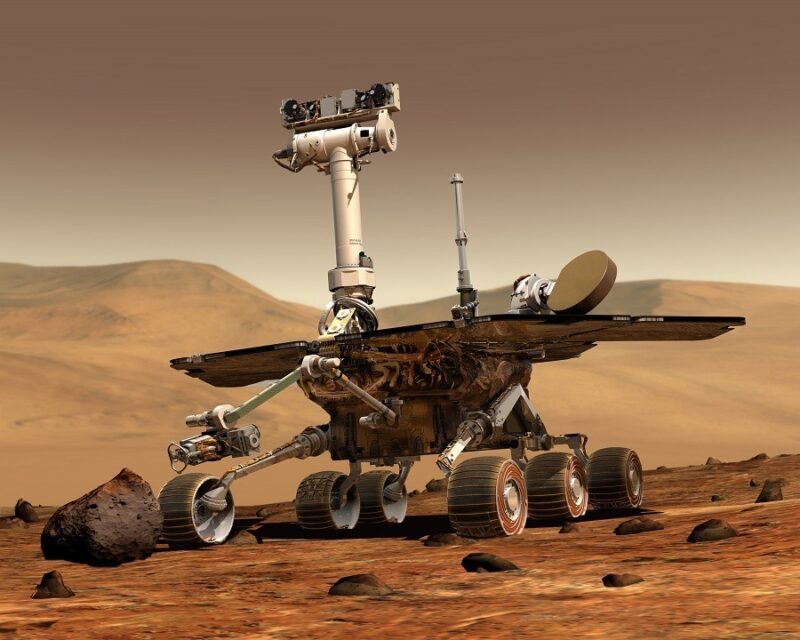
In the JPL control room, everyone is holding their breath. It is exactly 9:48 p.m and the Mars 2020 mission lander has just entered the atmosphere of Mars at almost 20,000 km per hour. You have just seven minutes to decelerate to 2.7 km / h, the speed of a person walking, and land softly on the red planet. The so-called ‘seven minutes of terror’ have just begun, the most complicated of the entire journey and during which the spacecraft cannot be directed from Earth. Now everything depends on the intelligence of the ship itself and the exact place that it selects, after checking the terrain during its vertiginous descent, to land.
Just ten minutes earlier, at 21:38, the descent module had successfully separated from the cruise stage, which carried it attached to its ‘belly’ during a journey of almost seven months and 470 million km through space. But now he is alone and depends solely on himself. Any order sent from Earth would indeed take 11 minutes to reach it, much longer than the entire landing maneuver takes. A minute has passed since entering the atmosphere and things are getting red hot. The friction has generated intense heat and now the module, with the Perseverance rover and the Ingenuity mini helicopter inside, has to withstand temperatures of up to 1,300 degrees Celsius, almost at the limit of resistance of the heat shield that faces the descent and prevents Have your valuable cargo incinerated in an instant. The atmospheric friction, however, contributes something positive: it has slowed the ship, which now falls ‘only’ to about 1,600 km / h.

Still, the speed is excessive. To reduce it, even more, it will be necessary to deploy a large parachute, and the exact moment to do so will be decided by a new automatic system, Range Trigger, which calculates in real-time the distance to the ground, which at the moment is about 12 km. Finally, the parachute opens, at supersonic speed, three minutes later, at 9:52 p.m. Another 20 seconds pass and it is time to get rid of the heat shield at the bottom of the ship, which has already done its job. The protective cap is detached and Perseverance, with the Ingenuity helicopter attached to its belly, is exposed for the first time to the air of Mars. Now the rover can use its radar to determine the exact distance to the ground at any given moment, and also use its innovative navigation technology to study the terrain and select a safe place to land within the Jezero crater, from 48 km in diameter and close to the planet’s equator.
Two minutes later (it is 21:54), the rear part of the module is also detached, together with the parachute to which it is attached, a maneuver that leaves the descent stage in the air, equipped with four pairs of retro rockets and which will finish braking the ship taking her to the landing point of her choice. As it does so, it will also carry out a so-called “overhead crane maneuver,” which involves lowering the rover, held by nylon straps, to the surface.
It’s 9:55 p.m. and Perseverance is finally hitting the ground. The straps are released automatically and the descent stage rises and flies to go to fall several km away. It is time to send the telemetry data to mission control.
Suddenly it happens. It is 9:56 p.m. and the control room erupts with applause, whistles, and shouts of joy. Laughter and tears are mixed in a hubbub that releases all the tension accumulated in ten long years of intense work. The last of them, by the way, is especially complicated due to the pandemic that plagues our planet, with its restrictions and multiple drawbacks. Two minutes later, the first images arrive. Perseverance has arrived on Mars, the mission can begin. The robotic geologist Mars 2020-Perseverance is already on Mars. The NASA rover has managed to land this Thursday in the Jezero crater, where it will look for signs of past microbial life. It is the largest and most sophisticated robotic vehicle ever to reach the red planet. It is also the most expensive since the total cost of the mission amounts to 2,700 million dollars (slightly more than 2,200 million euros).
As planned, at 9:55 p.m. the applause of the team gathered at NASA’s Jet Propulsion Laboratory (JPL), in California, announced that they had received confirmation of the successful landing of this robotic vehicle that since the launch of the last July 30, it has traveled 472 million kilometers. What an incredible team. It has overcome all the adversities that a landing on Mars entails, in addition to the challenges posed by Covid-19,” said Steve Jurczyk, acting NASA director, moments after landing on Jezero, a 45-kilometer-wide crater that scientists believe was filled with water 3.5 billion years ago.
“This mission embodies the human ideal of perseverance and will help us prepare for the exploration of Mars that we humans do in the 1930s,” added Jurczyk.
As explained by Jessica Samuels, one of the scientific managers of the mission, in the next few hours they will verify that all the systems and instruments are working well to begin operations. One of the main instruments of the rover has been manufactured by Spanish researchers from the Center for Astrobiology (CAB / CSIC-INTA). This is the MEDA meteorological station, which, in addition to measuring parameters such as temperature or pressure, will study Martian dust, something essential for these future manned missions. Likewise, a team from the University of Valladolid has participated in SuperCam, an instrument that uses a pulsed laser to study the chemistry of rocks and sediments, and has its microphone to help scientists better understand the properties of rocks. , including its hardness.
SAMPLE COLLECTION
Perseverance, with six wheels, about three meters in length and 1,025 kilograms in weight, will look for traces of past microbial life on this planet that in the past was similar to our own. It will work together with another NASA rover, Curiosity, which has been exploring Mars since 2012, and another static robot called Insight, which investigates the interior of the planet. This fleet of robots will be joined by a Chinese rover in May if the Asian giant also manages the complex task of landing. In addition to doing its on-site analyzes, the Perseverance rover will store the most relevant samples it finds because the plan is that a future NASA and European Space Agency (ESA) mission that is under study will collect them within a few years and bring them to Earth so they can be analyzed.3
Perseverance is the most sophisticated robotic geologist ever created, but to verify that microscopic life existed we will need a great deal of evidence. Although we will learn a lot with the excellent instruments that the rover carries, laboratories and instruments like the ones we have on Earth may be required to tell us if the samples contain evidence that Mars was home to live, “said Lori Glaze, director of the NASA Planetary Sciences Division.
Along with the Perseverance robotic vehicle, NASA’s Mars 2020 mission comprises a small helicopter called Ingenuity, which weighs 1.8 kilograms. If the tests of the first helicopter to make a controlled flight on Mars go well, it will be used in future missions to explore caves, mountains, and other hard-to-reach places.








